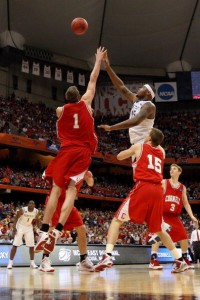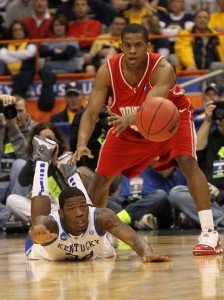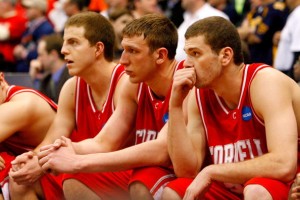Cornell Men Complete Magical Run in NCAA Tournament
Whenever it was going to come to an end, the Cornell Men’s Basketball team wasn’t going to go quietly this year. The most successful season in program history saw the Big Red post victories over Alabama, Massachusetts, Vermont, Davidson, and St. Johns in the regular season. After winning its’ third straight Ivy League Championship it was onto the NCAA Tournament for the third straight year where they notched their first ever NCAA win with a 78-65 victory over fifth-seeded Temple.
Their second ever NCAA win followed with an impressive 87-69 win over Big Ten foe Wisconsin (No. 4 seed) which sent Cornell to their first ever NCAA Sweet 16, the first Ivy League school to do so since Penn in 1979. Along the way, The Big Red set a school and Ivy League record with 29 victories, finishing 29-5. While Cornell’s NCAA Tournament run ended with a 62-45 loss to top-seeded Kentucky in the NCAA East Regional Semifinals at the Carrier Dome in Syracuse, NY on Thursday March 25, the Big Red played with Kentucky nearly the whole game. Refusing to let the Wildcats run away with it, Cornell gave a spirited performance behind the leadership of its’ senior laden team and 10-year veteran head coach, Steve Donahue.
To say the 12th-seeded Big Red were the underdog against Kentucky would be accurate, but not do Cornell justice. Being the lowest seeded team to reach the Sweet 16 certainly meant that they were going to face tougher competition. Yet it didn’t bother the Big Red.
This was a team that took preseason No. 1 Kansas to the wire this year on the Jayhwaks’ home court before coming up on the short end, 71-66. Kansas earned the tournament’s top overall seed and was favored by many to win it
all before losing to ninth-seeded Northern Iowa 69-67 in the second round. Against Kenutcky, the Big Red was in the game nearly the whole 40 minutes and controlled the tempo throughout the majority of the game.
With Cornell excelling in their halfcourt offense and Kentucky liking to get out and run, this was a game of contrasting styles. Yet each team came out a bit tight as both squads missed their first two shots. It took several possessions before the first points of the game were scored.
Big Red senior 7-foot center Jeff Foote scored on an inside pivot play 1:31 into the game as Cornell grabbed a 2-0 lead. The Big Red surged out to a 10-2 lead in the first 4:44 of the game as hundreds of Cornell fans erupted with cheers.

Jeff Foote of Cornell goes for the block as Kentucky's DeMarcus Cousins shoots.
The opening run had a typical Big Red feel to it as all five players on the court moved well without the ball to get quality shots. The 10 points came from Foote’s lay-up, a 3-pointer by Ryan Wittman on his first attempt from behind the arc, and five points from Louis Dale who started 2-for-3 from the field including one trifecta.
Cornell’s defense was strong in the first five minutes as they limited the Wildcats to one shot on several possessions and had three different players account for its’ five rebounds. The Big Red had the early lead and momentum with their fans fully behind them. While Cornell would be outscored 30-6 the rest of the first half and trailed 32-16 at intermission,
they regrouped at the break.
Kentucky’s 16-point halftime lead was mostly a product of outscoring the Big Red 24-6 in the paint and 13-0 on the fast break. Donahue and his coaching staff made some great adjustments at the half. The Wildcats had only a 12-6 edge in points in the paint in the second stanza and a 2-0 edge in fast break points.
Before the game, if one knew that Cornell would not score any fast break points and allow Kentucky to have a 36-12 scoring advantage in points in the paint, most would think the Big Red would have been blown out. Yet, that was not the case. Statistics don’t always tell the whole story.
Although The Wildcats had a 41-28 edge in rebounds, Cornell’s team effort on the boards kept them in it. Foote lead the Big Red with six rebounds and was one of eight Cornell players to pull down at least two boards.
The Big Red also did a great job of contesting Kentucky’s shooters as the Wildcats finished just 2-for-16 from behind the 3-point line which included an 0-for-7 effort in the second half.
If there was one statistic that hurt Cornell, it was turnovers. Entering the game, the Big Red forced an average of 13.6 turnovers a game and 50 more on the season than they committed. Against the Wildcats, Cornell scored just six points off 13 Wildcat turnovers while Kentucky scored 19 points off 15 Big Red turnovers to make Cornell pay. While that eventually doomed the Big Red, it didn’t stop them from competing to the very end.

Louis Dale moves around DeAndre Liggins to gather a loose ball for Cornell
Both teams came out cold in the first two and one-half minutes of the second half as Cornell missed its’ first four shots and did not capitalize on a steal by Dale. Meanwhile, The Big Red defense was holding steady as the Wildcats committed three turnovers and missed their only shot, a trey.
Dale scored the first points of the second half on a lay-up at the 17:29 mark. That would be part of an 18-8 run that pulled Cornell within 40-34 following a Dale 3-pointer with 5:42 to play. The leadership and experience of the Big Red coaches and players had weathered the storm and kept Cornell in it.
With hundreds of faithful Big Red fans standing and shouting “LETS GO RED”, it was anyone’s game. Then Kentucky scored six straight points to double its’ lead, 46-34 with 3:54 left to play. Wittman hit a 3-pointer nine seconds later to pull Cornell back to within nine at 46-37. However that is as close as the Big Red would get the rest of the way.
Knowing that he had guided his team to the brink of eliminating Kentucky

Seated from left to right are Cornell's Ryan Wittman, Jeff Foote, and Jon Jaques, all seniors.
(who many people picked to win it all after Kansas was upset), Donahue pulled his starters with 35 seconds left to play. It was to a standing and loud applause from all of the Cornell faithful in attendance as Wittman, Jaques, Wroblewski, and Foote all exited a basketball court for the final time this season with Wittman, Jaques, and Foote all doing so for the final time as collegians.
The ovation continued back home in Ithaca, NY on Friday March 26 when fans greeted the Big Red players and coaches as they exited the team bus back on the Cornell Campus. Foote, a local favorite who graduated from nearby Spencer-Van Etten High School, signed autographs. While the season ended sooner than anyone wanted it to, it was obvious that the Big Red had just completed a special and unprecedented season.
Here is a look at some of the Big Red’s individual and team achievements in athletics and academics this season:
PLAYER HONORS AND STATISTICAL MILESTONES:
·Senior forward Ryan Wittman became the fifth Ivy League player to reach 2,000 career points during his 24-point effort in the NCAA win over Wisconsin, ending that game with 2,018 points. With 10 points against Kentucky, Wittman finished his career with 2,028 points, extending his record as Cornell’s all-time leading scorer.
·Wittman’s selection as Ivy League Player of the Year made him only the third Cornellian to receive the league’s top award. He joined Ken Bantum (1984-85) and Louis Dale (2007-08). Wittman was a unanimous pick for first team All-Ivy honors for the third straight year.
·Seniors Wittman, Louis Dale, and Jeff Foote were all named first-team All-Ivy marking only the seventh time in Ancient Eight annals that three teammates were named to the first team in the same season and the first time since Brown placed three in 2003 (Jason Forte, Earl Hunt, and Alai Nuualiitia).
·The Ivy League awarded a Defensive Player of the Year for the first time following the 2008-09 season with Foote garnering the inaugural award. He won it again in 2009-10.
·Ryan Wittman was named to the United States Basketball Writers Association All-District II team for the second time in his career. He was among 10 players from Division I schools in the states of New York, New Jersey, Delaware, Pennsylvania, West Virginia, and Washington, D.C. Eight of the players joining him on the team play in the Big East, while the 10th plays in the Atlantic 10. Joining Wittman on the team are Lavoy Allen of Temple, De’Sean Butler of West Virginia, Austin Freeman and Greg Monroe of Georgetown, Ashton Gibbs of Pittsburgh, Jeremy Hazell of Seton Hall, Wes Johnson and Andy Rautins of Syracuse, and Scottie Reynolds of Villanova. Interestingly, Wittman and Cornell played against Temple’s Allen (won 78-65 in the NCAA first round on March 19), Seton Hall’s Hazell (lost at home 89-79 on Nov. 20, 2009), and Johnson and Rautins of Syracuse (lost 88-73 at Syracuse on Nov. 24, 2009), while going 1-2 against those players’ teams this season.
·Ryan Wittman has been invited to compete in the Reese’s College All-Star Game and the ESPN 3-Point Shootout during Final Four weekend and will participate. The Reese’s College All-Star game will be held on April 2 and be broadcasted on CBS College Sports at 4:30 p.m. Two teams comprised of some of the top senior student-athletes in the country will be invited to play and there is no admission to the contest. It is the 22nd annual event, with the slam dunk contest and 3-point shootouts televised live on ESPN on April 1 from 9-11 p.m. Past participants and champions in the shootout include Aaron Brooks, Steve Nash, and Kyle Korver. Witttman will be one of eight seniors selected to participate in the 3-point competition.
·Cornell senior forward Mark Coury played two seasons for the University of Kentucky, including starting for a majority of the 2007-08 squad. He averaged 2.0 points and 1.7 rebounds while starting 29 of 31 games for an 18-13 team that reached the NCAA Tournament. He also earned ESPN The Magazine Academic All-District Honors that season. He was a key reserve for the Big Red this season as he played in all 34 games and averaged 2.4 points and 2.4 rebounds.
·Ryan Wittman finished his storied career at Cornell as the school’s all-time career leader in seven statistical categories. They include points scored (2,028), field goals made (696), field goals attempted (1,520), 3-point field goals made (377), 3-point field goals attempted (875), games played (121), and minutes played (4,145).
·Ryan Wittman led the team in eight statistical categories in 2009-10 including points scored (596), scoring average (17.5), field goal attempts (439), field goals made (208), 3-point field goal attempts (256), 3-point field goals made (109), minutes played (1,154), and average minutes played (33.9).
·Ryan Wittman’s 109 3-pointers this season was a single season career high and set Cornell and Ivy League single season records as well.
·Ryan Wittman was named the Ivy League Player of the Year, joining Louis Dale (2007-08) as the only active teammates who have won their league Player of the Year awards.
·Sophomore guard Chris Wroblewski was an honorable mention All-Ivy pick.
·Senior Louis Dale ended his career as just one of five players in Ivy League history to record 1,400 points, 400 rebounds, 400 assists, and 100 steals in a career. Dale finished his career with 1,452 points, 432 rebounds, 470 assists, and 128 steals. In doing so, he joins Penn stars Michael Jordan (1,602, 443, 469, 146) and Jerome Allen (1,488, 482, 505, 166), Brown’s Jason Forte (1,597, 401, 514, 192), and Harvard’s Jeremy Lin (1,456, 485, 400, 222) in this selective group.
TEAM ATHLETIC ACHIEVEMENTS:
·Cornell is the first team besides Penn or Princeton to win three consecutive outright Ivy League Championships.
·Prior to its’ 62-45 loss to Kentucky in the Sweet 16, Cornell was 1-0 all-time against the Wildcats. The Big Red shot 58 percent from the floor and won 92-77 on Dec. 28, 1966 in Lexington, Ky., defeating the Wildcats who were the defending national runner-up. Gregory Morris, a 6-0 junior, scored 37 points on 16-of-21 shooting for the Big Red and grabbed 11 rebounds while Walt Esdaile scored 18 points. Basketball Hall of Famer Pat Riley scored 24 points and grabbed 11 rebounds while Louie Dampier added 18 points for Kentucky.
·Following their 62-45 loss to Kentucky on March 25 (top seed in the east region), Cornell played against three of the number one seeds in this year’s tournament with Duke (top seed in the South Region) being the lone exception. The Big Red lost at Syracuse (top seed in the west region) 88-73 on Nov. 24 and lost at Kansas (top seed in the midwest region) 71-66
on Jan. 6.
·The Big Red won its’ fourth Ivy League Title in school history and its’ seventh conference title of any kind with a 95-76 win at Brown on March 5.
·Cornell’s 74-60 home win over Brown gave the Big Red its’ fourth 20-win season in program history. It also secured three straight 20-win seasons for the first time in 111 years of Big Red basketball.
·Cornell set team records for points (2,545), field goals made (913), 3-pointers made (326), blocked shots (127), and games played (34) in 2009-10.
·The Big Red earned its’ first victories over a Big East team (St. Johns) and an SEC team (Alabama) since 1969 and 1972 respectively.
·Cornell finished first or second in the Ivy League in 16 of 22 team statistical categories and led the conference in 10 this season.
·Cornell’s 50-47 home victory over Princeton on February 26 notched the Big Red’s third consecutive 10-win league season, something it had not done since posting at least 10 league victories from 1964-65 to 1966-67.
·Cornell is 38-4 in Ivy League play over the last three seasons and 47-9 over the last four seasons.
·Cornell climbed as high as No. 22 nationally in the ESPN/USA Today Coaches’ Poll, the program’s first national ranking in 59 years.
TEAM STATISTICAL NUGGETS:
·The Big Red finished the 2009-10 season:
·21-1 when outrebounding its’ opponent.
·2-4 when trailing at halftime
·0-4 when trailing with 10 minutes left to play
·1-4 when trailing with five minutes left to play
·7-5 when committing more turnovers than its’ opponent
·18-4 when the game was decided by 10 or more points
COACH DONAHUE HONORS:
·Cornell head coach Steve Donahue has steadily built the Cornell program. Since going 2-12 in the Ivy League in his second year in 2001-02, Cornell has won more Ivy League games each year peaking with an unblemished 14-0 mark in 2007-08. After finishing 11-3 in 2008-09 when they won their second straight league title, Cornell went 13-1 in 2009-10 en-route to their
third straight Ivy League Championship and NCAA Tournament bid.
·Steve Donahue has been named the National Association of Basketball Coaches District Coach of the Year and was named the mid-season Hugh Durham Coach of the Year by collegeinsider.com as the top mid-major coach in the country.
·Steve Donahue is also a finalist for both the Hugh Durham Award and the Jim Phelan Award for national coach of the year.
·Steve Donahue has also been named one of four finalists for the Clair Bee Award. The Clair Bee Coach of the Year Award honors a Division I men’s basketball coach who through his actions on and off the court makes an outstanding contribution to the sport of college basketball. The criteria for this award include a coach’s ability to inspire, motivate, coach, and educate his team to achieve its fullest potential while insisting upon and demonstrating outstanding character and academic success. Missouri’s Mike Anderson was the 2009 recipient of the award.
TEAM ACADEMIC HONORS:
·As a team, Cornell sports a 3.2 cumulative grade point average.
·Under head coach Steve Donahue, Cornell has had a pair of ESPN The Magazine Academic All-Americans, including a first-teamer in Graham Dow ’07, who was a Rhodes Scholar candidate.
·Five Cornell players (Jeff Foote, Alex Tyler, Adam Wire, Ryan Wittman, and Chris Wroblewski) are enrolled in Applied Economics and Management, the No. 5 undergraduate business program in the country by Newsweek.
PLAYER ACADEMIC HONORS:
·Senior reserve guard Geoff Reeves and sophomore guard Chris Wroblewski were named to the ESPN The Magazine Academic All-District 1 team. Reeves sports a 3.54 grade point average in Agriculture Sciences, while Wroblewski has a 3.58 GPA in Applied Economics and Management.
·Senior forward Ryan Wittman (Applied Economics and Management) was named to the 2007-08 and 2008-09 Academic All-Ivy League teams.
·Senior Mark Coury (Applied Economics and Management) and freshman Eitan Chemerinski (Applied Economics and Management) were both members of the 400 club, joining an exclusive group of Cornell student-athletes to post a grade point average of 4.0 or better this past fall.
